To most people the Titanic disaster is more of a legend than reality. An event in time that sent such shockwaves through history that people couldn’t believe it actually happened.
There have been many other ships that have foundered with a great more many casualties, but there’s something about Titanic that seems to enthrall us. Since the disaster nearly a century ago there have been at least four major films, countless television programs, books, newspaper and magazine articles, model kits, memorabilia.
The list of collectables available to the fanatic is almost endless. There is something about the disaster that captivates people young and old from all walks of life throughout the globe.
My whole experience was filmed for a History Channel documentary, “Titanic – A Tale of Two Journeys” which is available on DVD. I also give talks on my experience, details of which can be found on my website www.robgoldsmith.co.uk
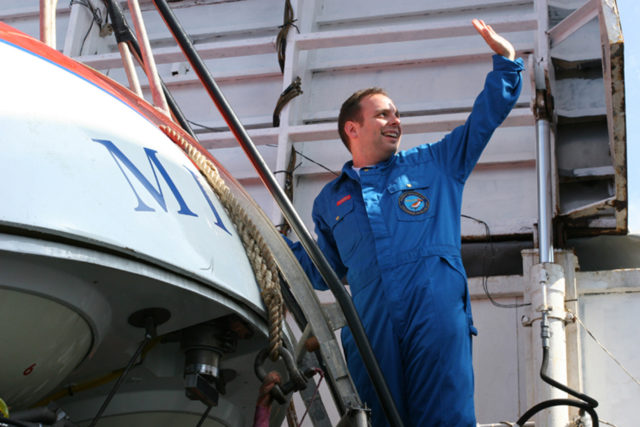
That something captivated me in 1985 when I was an 8 year old schoolboy, as it did with many others when the wreck was finally discovered by Robert Ballard and his team. Who’d have thought, that almost exactly twenty years after that first interest, I’d become one of the very few people in the world to actually see the wreck of the most famous liner in the world sitting two and a half miles under the Atlantic Ocean.
Only a few weeks before I was an average person leading an average life, and although my interest in the Titanic was one of sheer fascination, actually seeing the ship was merely a pipe dream, something I considered to be out of reach, like climbing Everest or flying into the frontiers of space. But on July 12th 2005, there I was, staring out of a 7 inch porthole at the most famous shipwreck in the world with my own eyes.
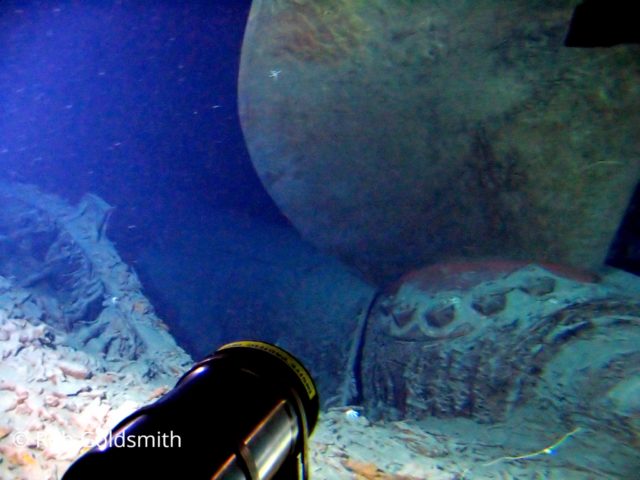
So the story for me begins in April 2005. The History Channel are running a series of programs about the Titanic to link in with the anniversary of its demise, as well as a competition. The prize? To win a trip down to the actual wreck! I had no hesitation in sending the answer to the question “In which year did it sink” and then completely forgot about it!
Three weeks after sending the text I get a phone call from someone at The History Channel telling me I’d been randomly picked out of 30,000 entries to battle it out with 5 other finalists at the BAFTA building in London to win the trip! So on June 11th my father Danny and I went up to London for the interview day. I’m the second out of the six to be interviewed and it lasted about 20 nerve-racking minutes. After the interviews were over we had an hour to wait.
This hour was the longest of my life. It’s hard not to feel optimistic, yet at the same time I was sure that someone else would win it. We get called back in the room, by this point I’m shaking with nerves. Then suddenly I hear my name. Clear as a bell. I’d done it. I’d won the trip of a lifetime to see the ship I’d had a fascination in for twenty years, I was going to TITANIC.
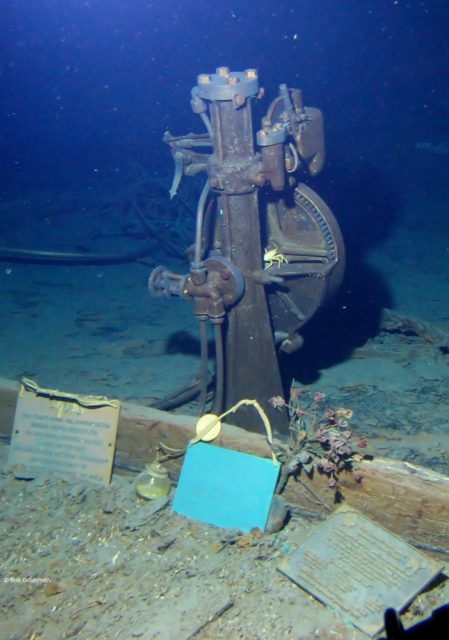
On Wednesday 6th July we arrived in Newfoundland. The following day we boarded our ship, the RV Akademik Mstislav Keldysh. The Keldysh is a working vessel and far from luxurious. Cranes, cables and machinery litter the metal deck. The smell of diesel fuel filled the air and the noise from the engines could be heard echoing off the surrounding buildings along the quayside.
The interior of the ship was very 1980’s in style, with fake wooden paneling donning the walls and a brown carpet on the floor. The portholes had yellow floral curtains in front of them. Nothing wrong with that, except the curtains didn’t actually cover the portholes. At the end of the day it’s a working ship, if I wanted luxury I would’ve gone on a cruise liner.
We set sail on the afternoon of the 7th we arrived at the wreck site the evening of the 8th. Once we were at the location of the Titanic the Keldysh would circle Titanic and drop a transponder near her four corners. This was done to make sure the Keldysh would hold her position and to unsure the Mir submersibles didn’t get lost on the way down. The transponders were effectively a safety net for both the Keldysh and the Mirs.
12th July was my dive day. My journey to the wreck site started at 9:30am. I was to dive down in Mir 2 and my pilot for the journey was Genya Cherniaev. Genya has made over 50 dives to Titanic and is considered to be one of the most experienced pilots.
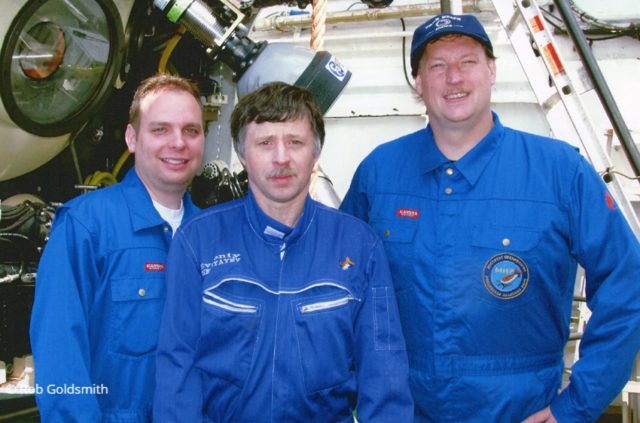
After putting on my Nomex fireproof suit I gathered together my camera equipment then made the long walk from my cabin to the Launch Room. It is here you effectively sign your life away. I proceeded out into the hanger bay with my crewmate and here photos were taken and last minute checks were made to Mir 2.
Once Genya arrived we climbed aboard the Mir, pausing occasionally for the last minute photos and to remove our shoes. The inside of the submersible is cramped and packed full of sensitive equipment so hard footwear is not permitted. Once in the sub it took me a few moments to get settled as there is little room to move about. The engineer and pilot exchanged a few words and the hatch was closed. At this point the emotions running through me changed rapidly between fear, nerves and excitement.
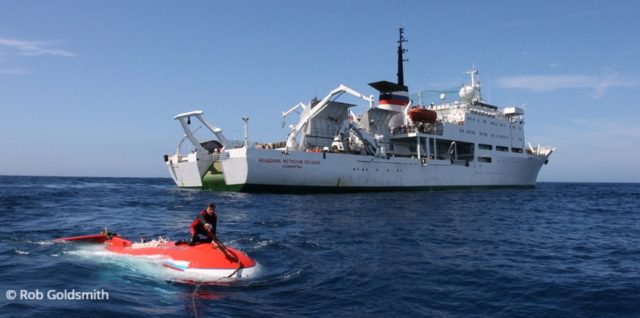
The support vessel Koresh is the first overboard. This little boat plays a large role in the submersibles’ launch. One of its primary roles is to prevent the submersibles from banging into the hull of the Keldysh as they are being lowered into the ocean. An incident like this could cause micro fractures in the nickel steel sphere thus endangering the lives of the occupants.
The next vessel to be launched is a small, powered rib containing the “Zodiac Cowboy.” It’s the cowboy’s job to disengage or engage the umbilical that’s connected to the Mir. This involves him going out to the Mir in the rib and jumping on the Mir’s roof. In the rough seas of the Atlantic Ocean the Mir moves around like a bucking bronco, hence the nick-name, cowboy.
One of the crew hooks up an umbilical to the top of the submersible and the crane picks us up and gently swings us over the side of the ship. Even though I’d seen this procedure from on board the Keldysh, it was a whole different experience being inside the sub. Crew members pull on ropes to prevent the 18 ton Mir from getting a swing-on and banging into the Keldysh.
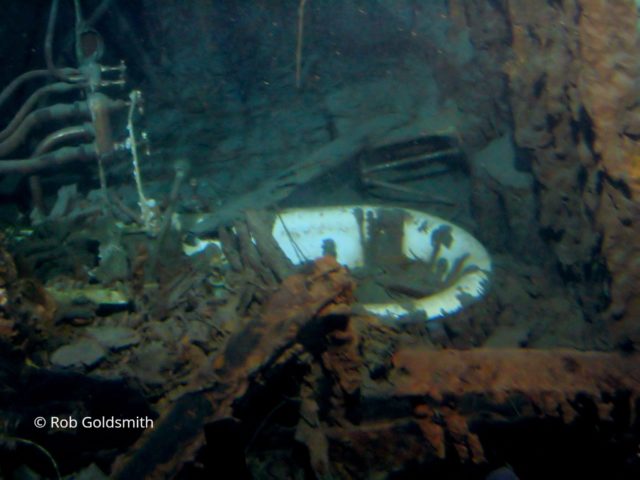
Once ready the crane rotates the Mir so it faces away from the ship. As the crane lowered us into the water the vast expanse of the Atlantic Ocean closed around the porthole and the familiar, comfortable surroundings of the Keldysh disappear out of sight. The cowboy then jumps on the back of the Mir and disconnects her from the umbilical that links her to the Keldysh. The Koresh then pulls the submersible away from the ship. Once out far enough the cowboy disconnects the towing rope connected to the Koresh and jumps back aboard his RIB.
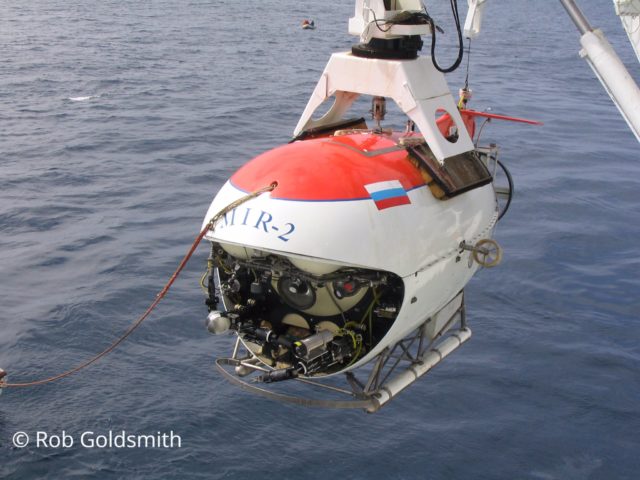
After a few moments Genya blows the ballast tanks and we slowly began our descent to the sea floor two and a half miles beneath us. The water around us went from a bright blue through green, dark blue and then finally black as the sunlight disappeared. It takes the Mir between 2 and 3 hours to reach Titanic, travelling at around 100ft a minute. If there are any problems on board the submersible it is designed to jettison various parts including the propeller and battery packs in order to get back to the surface quickly. It is estimated that in an emergency the submersibles are capable of travelling 40ft per second.
I soon realized that this venture was not going to be a walk in the park. There are so many things that can go wrong at this depth. Snagging on the wreck is one; fire in the cabin is another, and of course flooding. The pressure at the wreck site is a tremendous 6,000 pounds per square inch. The only protection we would have is the Mir’s thick, nickel steel sphere. If something were to go wrong with the sphere then it’s safe to say that things are pretty final.
On our route down we made plans as to which parts of the ship we’d explore. We made good progress, reaching the sea bed within 2 hours. Seeing the sea floor coming up at you is like landing on the surface of the moon, nothing around except the flat sand and the occasional starfish and rocks that disappear into the blackness of the dark ocean.
Genya powered along the sea floor for a little way, then out of the darkness loomed the bow section of Titanic. Nothing I write here, no photo or video I take, can describe the sight of seeing the Titanic for the first time with my own eyes. It is quite simply the most amazing thing I have ever seen and probably will ever see. The bow is in remarkable condition; however the whole ship is gradually being eaten away by micro-organisms.
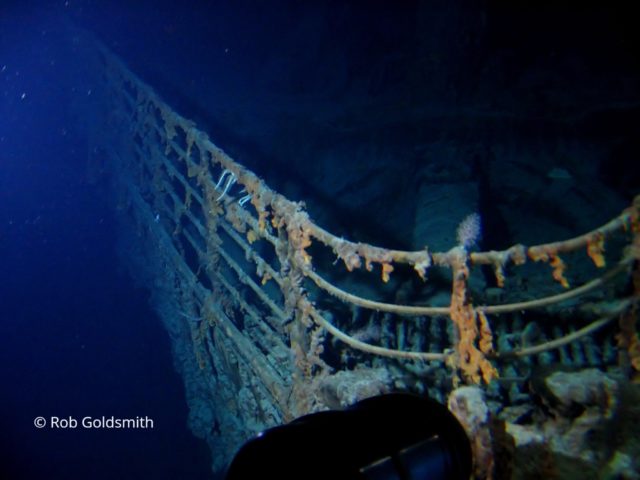
The coral like structures growing on the ship are called “Rusticles” and they are the secretions created by these microscopic creatures. As we explored the front section of the ship we rendezvoused with Mir 1. It gave the Titanic a whole new perspective being lit by both submersibles, and I could see detail I hadn’t picked up on before. It also gave the ship a strange, almost ghostly appearance. We circled the bow for a good forty five minutes, examining the port and starboard anchors as well as the centre anchor.
We then made our way over the bow to the forecastle. As we skimmed along the deck, I couldn’t believe how well preserved this area of the ship was, the capstans and bollards were still shiny, the anchor chains still visible. It was hard to believe they’d been down here for a century.
We continued our journey over the well deck then followed the path of the fallen mast. We glided gently over where the crows nest once was; unfortunately it fell off some years ago. The doorway is still clearly visible, as is the attachment for the ships bell just above it. We also found that the mast had broken just above the cargo hatch, which, as it transpired, was quite an important discovery.
As we made our way up the mast we saw one of the cargo cranes and behind it the deck wall with two portholes still visible. In some places you could even see the white paint. Above the portholes we noticed a gate still locked shut, presumably to prevent the 3rd class passengers from reaching the upper decks. We followed the fallen mast up to the bridge, All that remains here is the telemotor control, the rest has either been salvaged or eroded away over time. Some plaques in memory of all those who perished have been left by other visitors to the wreck.
We headed round to the starboard side of the boat deck. I could see the lifeboat davit still standing in the half cranked position, the pulley wheel is still attached. I tried to imagine what it must have been like for all those people in the lifeboats as this very pulley lowered them into the sea. This davit is one of only two still standing on Titanics boat deck. The other is on the port side, it’s still cranked out over the side of the ship: a poignant reminder of that fateful night.
We slowly moved round past the bridge to the starboard side of the boat deck. This is where the officers’ quarters are located. As we turned I got a view into Captain Smith’s bathroom as the outer wall to his cabin has collapsed. His bathtub is clearly visible and filled with rusticles. Just behind his bath tub are the remains of his sink, a large chunk of debris propped up against it.
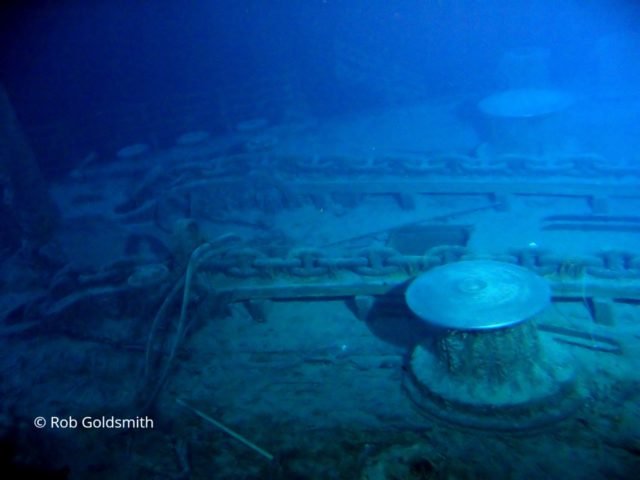
We headed over to the Officers’ Quarters on the port side. Over one door I was surprised to see a sign stating “Officers Entrance”, as though it were put there only yesterday. Windows could be seen still with the glass in, the frames still with flecks of paint on. Light fittings and railings were still in their place all along the boat deck. In front of the officers quarters stands one of the electric boat winches made by the Sunderland Forge and Engineering Co. These would have been used to assist in the lowering of the lifeboats. The manufacturers name is still visible. A skylight sits on top of the Officers’ Quarters bathroom. Although made of wood the skylight remains remarkably well preserved.
We then examined the Marconi room just aft of the Officers’ Quarters. This is where Jack Philips and Harold Bride sent the first S.O.S. You could just make out the remains of the Marconi equipment through the skylight. Genya decided to poke the camera on the front of Mir 2 in one of the windows to take a closer look. Sure enough all the equipment was still in place, covered with debris and rusticles.
Genya piloted the sub over to the Starboard side of Titanic. We then dropped down and headed along the first class promenade deck, the light from the Mir reflecting off the internal windows. As the promenade deck is directly below the boat deck, it’s widely believed that people were climbing out of these windows and boarding the lifeboats as they were being lowered.
After we had examined the promanade deck we descended further into the abyss. We headed along the starboard side to where the enomous crack is, just under the well deck. Scientists believe this was created when the Titanic hit the sea bed. Inside you could clearly see the different decks, as well as a sink and fallen ladder. Genya has to be very careful maneuvering the sub, there are a lot of sharp bits of metal sticking out that could either snag the sub or damage it.
As we approached the aft section of the broken bow, the extent of the destruction became clear. Large iron beams buckled over, bits of piping, railing and cables all strewn across the boat deck. One can only imagine the fear and horror that must have gripped those people on board the ship as it literally tore itself apart.
We dropped almost to the sea floor and examined the boilers which were once in boiler room two. Each boiler is massive, about the size of a small truck, and Titanic had twenty nine of them. Titanic would carry nearly 6000 tons of coal for one trip across the Atlantic, all shoveled into these boilers by hand.
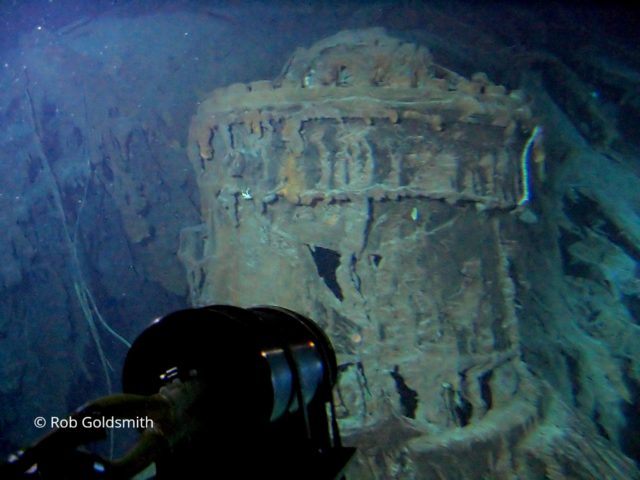
We then made our way across the debris field toward the stern section. Many items litter the debris field, the majority of pieces are from the ship itself such as flooring, piping and water tanks. But there are a lot of items that remind us of the human element to the disaster, and these I found to be the hardest things to deal with emotionally. Items such as dinner plates, bottles, tip basins, enamelled parts from beds, even a silver platter. These items weren’t put there by someone; this is where they landed in 1912, and they’re still there today. As there is little current down at this depth most of the items sit on the sea bed, barely covered in silt and as the microscopic organisms are quite fussy eaters, most are in remarkably good condition.
As we slowly moved around the debris field other items came into view. A huge cylindrical object, perhaps a water tank, with the ladder still attached, pipe work from the stern and a cup from 3rd Class, still with the White Star Line logo clearly visible.
On the sea bed, not far from the stern section, sits a water tank, it’s rivets still clearly visible. A lone plate rests neatly on top of it as though it were just placed there by hand, now with bizarre sea life growing out of it. Bottles of Champagne sit nearby with their labels still attached, most still corked. Other debris, including a toilet, surround the brightly coloured tank.
A single lifeboat davit lies near the stern section still in its open position, reminding us of that night. Like many items at the wreck site its brass turn screw looks almost new. One davit is partially buried, the other protrudes from the sea bed, the pulley still attached. Next to the davit sits a piece of piping from the stern section, crushed by the enormous amount of pressure. Near that sits a pulley from another davit.
As we maneuvered across the debris field we came across the stern section. The stern is a stark contrast to the bow. It’s now just a mass of tangled metal. Through the fallen decks you can still make out the graceful curve of the back. Underneath this sits two of the three mighty propellers, bent up on their wings with the force of the impact. The centre one, like the majority of the rudder, is buried deep in the silt. Genya very cautiously moved Mir 2 under the stern so we could get a close up view of the port side propeller. At this stage I was extremely nervous. Although not a natural seafarer even I know going underneath a ship wreck is extremely dangerous. Like everything else on Titanic, the propellers are huge, roughly 24 feet across.
A mass of metal and debris fallen from the stern surrounded us. We very cautiously backed away from the port side propeller and made our way up and over the aft. Silently we cruised across the remains of the stern section. Vast mountains of tangled metal fill the small porthole of the submersible. Out of the gloom an object appears in front of us, standing at an awkward angle. As we get closer the shape of a cargo crane blurs into view. One of the very few objects on the stern that’s recognizable.
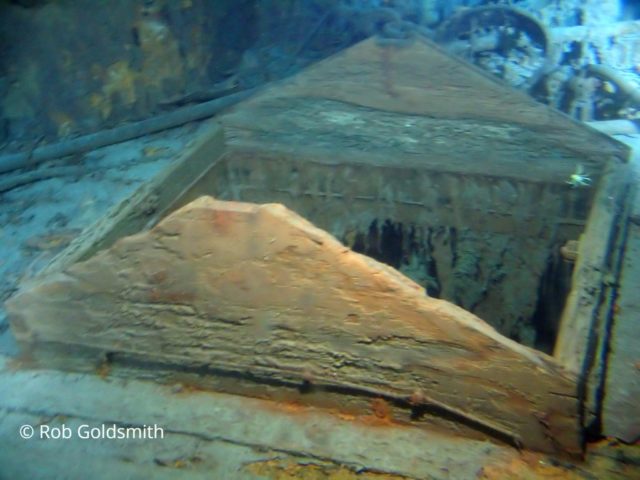
We carefully move across the mangled decks of the stern and dropped down alongside the massive engines, each standing nearly four stories high. They stand upright at the front of the stern, at the breaking point, almost like a gateway to the ship. It was here we decided to hold a minute’s silence in remembrance of those who perished. Although I was tremendously excited by the whole journey, it was at this point I felt a sense of guilt for being excited. This was a gravesite after all, and it should be treated as such.
It was now time to leave Titanic and we began our ascent back to the surface. It’s a strange feeling. As I watched the two engines disappear into the black abyss beneath me, I really didn’t want to go. A tear ran down my cheek: goodbye Titanic, and thank you for sharing your secrets.
It took us just over two and a half hours to reach the surface. On the way up we ate the emergency food supply (ham and cheese sandwiches) and Genya changed the Carbon Dioxide filters.
As we broke through the waters of the North Atlantic, darkness had set in and the weather had taken a bit of a turn for the worse. The sub was rocked back and forth by the strong cur-rent that now surrounded us. Unbeknown to us Mir 1 had surfaced several hours ago due to a technical problem with its hydraulics. This meant that if we’d got into any trouble at the wreck site we had no back up. In a way I was glad I found this out now and not when we were two and a half miles down.

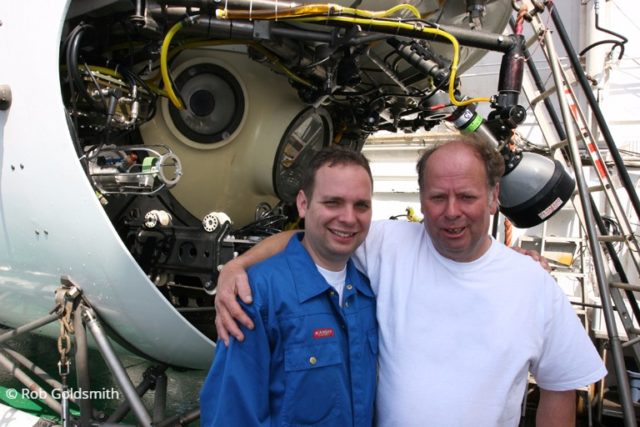
The cowboy jumped onto the back of the sub. Due to the rough conditions it took him almost 10 minutes to hook us up to Keldysh’s crane. Eventually he succeeded and the sub jolted as the crane hauled us back onto the ship. Very gently the sub was lowered back into its hanger. Through the 5 inch porthole I could see the people waiting on the deck.
Once the sub had been secured to the deck of the Keldysh Genya slowly opened the hatch. A rush of fresh air entered the submersible, a crew member stood on the outside smiling as he looked in. Both my crewmate and I came out to a round of applause and cheering from the onlookers and were both handed a glass of champagne each. My dad ran down to greet me and gave me a big hug, it was an incredibly emotional experience, he was so proud of me to have done such a thing and I was glad to have taken him along.
Saturday 16th July and unfortunately my time on Keldysh has come to an end, it’s been a tremendous experience that I will remember forever. I got to accomplish a lifelong dream and then some. I’ve become one of only a handful of people in the world to actually see the Titanic! We arrived back in St John’s harbour around 12 noon. Everyone quickly gathered up their stuff and disembarked the ship. The trip of a lifetime was finally at an end.
It’s now been several years since my trip to the Titanic wreck and the interest in my experience doesn’t show any sign of letting up. I’m still getting regular bookings for talks from both schools and clubs and the topic of conversation does pop up on a fairly regular basis, especially if the documentary has recently aired on television.
The Titanic story seems to capture people’s imagination, and I’m sure it will continue to do so for many years to come. In a strange way I am now part of that story and part of Titanic’s history, and may well be one of the very last members of the public to ever dive on her. I feel very proud to have had the opportunity to have visited the Titanic in her final resting place, and prouder still that I have been able to share that experience with so many people.
My whole experience was filmed for a History Channel documentary, “Titanic – A Tale of Two Journeys” which is available on DVD. I also give talks on my experience, details of which can be found on my website www.robgoldsmith.co.uk
I would like to thank all the people at the History Channel and Deep Ocean Expeditions for making a dream come true, especially Andrew Brooking and Robert McCallum. I’d also like to thank, Bridget Saar and Peter Batson for the use of their photographs. Most importantly I would like to thank my father Danny for supporting me on the trip and sharing the experience with me. We made a good team.